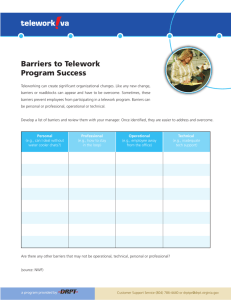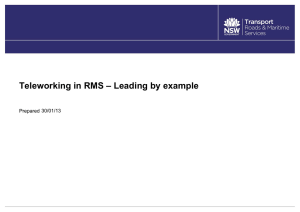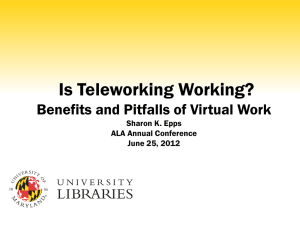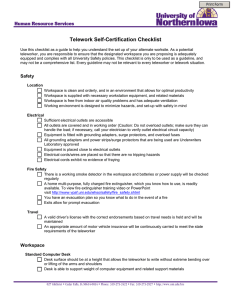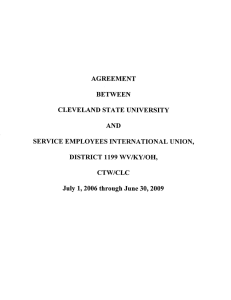Beyond the Borders: The Three Ts of Contemporary Protocols
advertisement
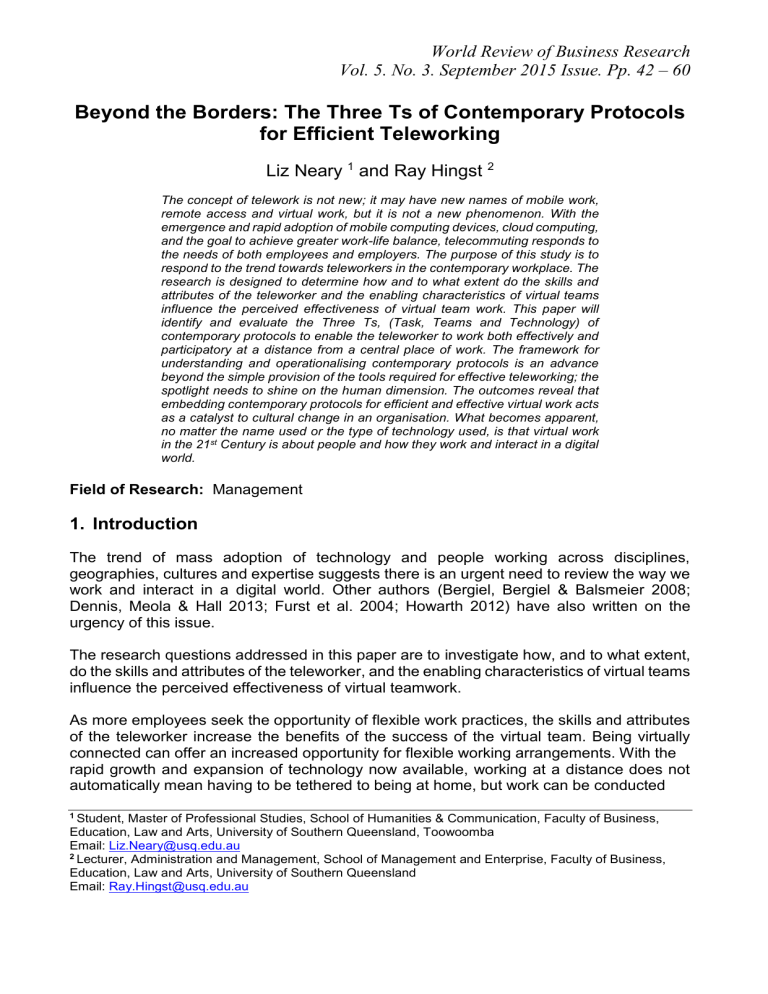
World Review of Business Research Vol. 5. No. 3. September 2015 Issue. Pp. 42 – 60 Beyond the Borders: The Three Ts of Contemporary Protocols for Efficient Teleworking Liz Neary 1 and Ray Hingst 2 The concept of telework is not new; it may have new names of mobile work, remote access and virtual work, but it is not a new phenomenon. With the emergence and rapid adoption of mobile computing devices, cloud computing, and the goal to achieve greater work-life balance, telecommuting responds to the needs of both employees and employers. The purpose of this study is to respond to the trend towards teleworkers in the contemporary workplace. The research is designed to determine how and to what extent do the skills and attributes of the teleworker and the enabling characteristics of virtual teams influence the perceived effectiveness of virtual team work. This paper will identify and evaluate the Three Ts, (Task, Teams and Technology) of contemporary protocols to enable the teleworker to work both effectively and participatory at a distance from a central place of work. The framework for understanding and operationalising contemporary protocols is an advance beyond the simple provision of the tools required for effective teleworking; the spotlight needs to shine on the human dimension. The outcomes reveal that embedding contemporary protocols for efficient and effective virtual work acts as a catalyst to cultural change in an organisation. What becomes apparent, no matter the name used or the type of technology used, is that virtual work in the 21st Century is about people and how they work and interact in a digital world. Field of Research: Management 1. Introduction The trend of mass adoption of technology and people working across disciplines, geographies, cultures and expertise suggests there is an urgent need to review the way we work and interact in a digital world. Other authors (Bergiel, Bergiel & Balsmeier 2008; Dennis, Meola & Hall 2013; Furst et al. 2004; Howarth 2012) have also written on the urgency of this issue. The research questions addressed in this paper are to investigate how, and to what extent, do the skills and attributes of the teleworker, and the enabling characteristics of virtual teams influence the perceived effectiveness of virtual teamwork. As more employees seek the opportunity of flexible work practices, the skills and attributes of the teleworker increase the benefits of the success of the virtual team. Being virtually connected can offer an increased opportunity for flexible working arrangements. With the rapid growth and expansion of technology now available, working at a distance does not automatically mean having to be tethered to being at home, but work can be conducted 1 Student, Master of Professional Studies, School of Humanities & Communication, Faculty of Business, Education, Law and Arts, University of Southern Queensland, Toowoomba Email: Liz.Neary@usq.edu.au 2 Lecturer, Administration and Management, School of Management and Enterprise, Faculty of Business, Education, Law and Arts, University of Southern Queensland Email: Ray.Hingst@usq.edu.au Neary & Hingst anywhere, any time. Developments in digital working hubs, co-working spaces and digital communities offer more freedom, providing individuals with options about how and where they work, meet, collaborate and find the best approach for given tasks (Mason & Buksh 2014). This paper builds on previous study by the researcher to determine how and to what extent do the skills and attributes of the teleworker, and the enabling characteristics of virtual teams influence the perceived effectiveness of virtual team work. To increase our understanding of these factors, the research design has been based on previous study by (Mogale & Sutherland 2010) which sought to understand the factors deemed to be important enablers or inhibitors of effective management of permanent virtual teams and the skills required to manage virtual teams. Other previous study has focussed on the tools for unified communication in virtual teams (Nabi 2013). This paper develops protocols to effectively unite the Three Ts, (Task, Teams and Technology) of telecommuting in order to provide a guide for implementation, integration and operation of the virtual workplace. Here we take task to mean the work to be done, the job/s to be performed, that is, the objective/s to which productive efforts are applied. Teams are taken to reflect a group which has advanced in its development to the point where members approach tasks interdependently; they rely on each other not just to perform work but also for supportive relationships which provide a level of cohesion and collaboration not evident to the same extent in workgroups. Technology represents the tools which the team uses to unite their efforts and facilitates the transfer and dissemination of data, information and knowledge and provides a conduit for communication and inter-personal connections necessary to enable the team to perform as a coherent identity. Our ‘protocols’ identify a number of considerations which complement the etiquette which teams in a conventional, face-to-face setting observe. It is anticipated that this study will establish and build on previous work to highlight effective and contemporary protocols for virtual teams to facilitate both the individual and the organisation; enabling the teleworker to work effectively and efficiently at a distance from a central place of work whilst ensuring the organisation’s goals are met. Developing the skills and attributes to working from a distance, when successful, creates an organisational culture and a set of capabilities which enables the organisation, and the individual, to enhance and embrace the opportunities and benefits of flexible work practice. Telework may not change the skills and attributes of the individual compared to working in a physical office space however it is the presence of these characteristics which may influence teleworkers’ work outcomes and attitudes. A limitation in the previous study has been the focus on one large global organisation (Mogale & Sutherland 2010). This broadly aligns to the limitation in this study being that it was focused on one regional Australian university. It is acknowledged that further investigation of other regional Australian universities and industry bodies may help in addressing this limitation. The paper is structured as follows. Firstly, we present telework as a rapidly growing, flexible work practice that can be of benefit to both the employee and the employer. We consider the benefits of flexible work practices and potential key benefits of a flexible workplace in regional Australia. Then to understand to what extent the skills and attributes of the teleworker, and the enabling characteristics of virtual teams influence the perceived 43 Neary & Hingst effectiveness of virtual team work, we analyse the data collected from a voluntary, online survey. Next we discuss how the results can be grouped into three themes (task, teams and technology). Finally, we conclude with suggestions for the protocols to be used by virtual teams and possible future research direction. 2. Literature Review The concept of telework is not new; it may have a new name and the definition of telework may have evolved somewhat with the significant growth in the information and communications technology (ICT) technologies and mobile devices, but it is not a new phenomenon. In the early 1970’s the topic of telework started to gain publicity in academic circles. At the time, it was the energy crisis that led researchers to consider telecommuting as an alternative to physically commuting. The issues of rising real estate, rental costs and problems with traffic congestion were also key factors (Felstead 2012). Thousands of companies and millions of employees in a wide range of industries across the globe have already successfully adopted a wherever, whenever approach to work (Lister & Harnish 2011; TeleworkAustralia 2014). They are proof that the traditional barrier to telework, that of management mistrust, can and should be overcome because the triple benefits are worth the effort; financial, social and environmental. And those companies have led the way by perfecting best practices that address the security, communications, and collaboration, managerial and social aspects of remote work with a combination of technological and cultural solutions (Lister & Harnish 2011). By offering workplace flexibility and measuring performance based on results, rather than presence, changes to the nature of work should continue to evolve and mature. Telework Australia defines telework as: “work from a distance” (2014), although it has many forms and labels, including remote access, remote work, mobile work, e-work, telecommuting, working from home and more. The word has also been defined in many different ways; some accentuate the role of technology whilst some focus only on workers based in home offices (TeleworkAustralia 2014). Telework has attracted interest from diverse quarters. What has consequently emerged is not one but a variety of discourses about telework, involving different images of the teleworker, different problems for which telework is a solution and different perspectives from which to evaluate this phenomenon (Haddon & Silverstone 1992, p. 3). The days of when paid employment was confined to designated hours in a specified place are fast fading, particularly for managers, professionals and other white-collar workers. Internet connectivity, email, mobile phones, laptops and notebook computers mean that work can be done wherever we are and whatever the time (Felstead 2012). The interface between portable computing and telecommunications and the development of network and collaboration technologies seamlessly connecting people and information around the globe has enabled more effective telecommuting. This advanced development in electronic communication and information technology (ICT) within the workplace, along with a need to compete globally and address competitive demands via accessibility to skilled resources, has forced organisations to embrace teleworking and virtual teams. Recent announcements by Google and Yahoo about flexible work practices have sparked new interest and debate about the management of those who have the capacity to work from virtually anywhere. At a time when more employees are recognising the benefit of telework, Google and Yahoo’s announcements seem particularly out of sync with current 44 Neary & Hingst trends (https://www.infoxchange.net.au/news/did-yahoo-get-it-wrong). While telework / telecommuting / flexible work might have been on the management agenda for some Australian organisations, it may be the case that management are now rethinking their plans and strategies as a result of the debate of management versus the productivity and trust of the flexible worker (Bosua & Gloet 2013). Mahler (2012) states that the common characteristics of all forms of virtual organisation are that teleworkers are separated by distance and time and interactions occur synchronously or asynchronously using a variety of communication and information technologies. In some agencies teleconferencing and videoconferencing capacities permit members to hold webinars and collaborate in real time. Podcasts and Webcasts allow meeting events to be viewed later or archived for public access (Mahler 2012, p. 409). Training is another activity in which teams typically participate and, not surprisingly, applications have been developed to exploit the technological platform to meet the professional development of teleworkers (Courville 2009). Australia’s National Broadband Network (NBN) is one platform touted as increasing the capability of being able to telework, no matter the location or the profession. However this increase in technological capabilities is not the only factor driving the changes in the nature of our work. The potential key benefits of a flexible workplace are substantial in terms of time savings, a reduced need for expensive office space, workforce participation and staff turnover; important factors for the future of regional Australia. Factors of talent shortages, changing workforce dynamics and employee burnout, worries over natural disasters, and terrorism, are now likely to drive more widespread adoption of teleworking. Additional factors of increased productivity, improved moral among employees and a more balanced work/life benefit can further assist companies to recruit and retain employees (Department of Communications 2013). Employer expectations are also added drivers in this changing nature of the workforce. Less distractions and interruptions as well as the flexibility over their work schedule, enabling more control over when and how they work, are highlighted as important factors. 2.1 The Need for Protocols Research indicates that one of the most critical challenges facing organisations is developing leaders with the requisite skills to succeed in the global and complex work environment. Work using a virtual approach appears in almost all organisations but in a wide array of configurations, from one person working remotely to whole offices co-located (Dennis, Meola & Hall 2013). Management resistance seems to be fuelled by misconceptions and fears of many leaders. Do work flexibilities offer advantages to the employer or is it just another benefit to the employee? Does out of sight equate to out of mind, therefore leading to a disconnection between the leader and the flexible worker? Detachment of work from place has consequences for how and what the workers involved have to learn to survive and prosper. Physical proximity with co-workers and the simple ritual of the physical handshake can be lost (Felstead 2012). The benefits and challenges of teleworking highlight the importance of embracing contemporary protocols and understanding what structures are needed to ensure successful engagement of the team; the goal of any team is to deliver results and should not be measured by the time spent in the office working. The challenges of always being connected, heightened levels of selfdiscipline and understanding what works where and how, are highlighted. The need to establish trust and collaborative relationships amongst team members whom have never 45 Neary & Hingst met and know little about where they live effect the dynamics and long term survival of virtual teams. The need to communicate primarily through technology means the building of trust and effective relationships are important challenges (Felstead 2012; Khan 2012). In this new and advanced world, providing individuals with options about how and where they work and treating people as grown-up to find the best approach for the given task presents challenges as well as opportunities. Protocols for operationalising telework represent an advance beyond the simple provision of the tools for the task; the spotlight needs to shine on the human dimension. “To achieve the benefits of telework as part of flexible workplace practices, telework should not be treated simply as an add-on to existing work practice and management systems” (Department of Communications 2013). Previous study conducted by Mogale and Sutherland (Mogale & Sutherland 2010) focussed on the relative importance of key virtual leadership skills, as well as the enablers and inhibitors of managing virtual teams successfully. Whilst a number of factors from that study were found to be similar to our research, the aim of their study was to discover which leadership style is preferred in a virtual team environment. The focus of our study is to investigate how and to what extent do the skills and attributes of the teleworker/virtual team member, and the enabling characteristics of virtual teams influence the perceived effectiveness of virtual team work. In order to move beyond teleworking and build capacity to create a digital presence, fundamental protocols should be explored. In order to make teleworking/virtual teams successful, protocols can ensure an appropriate standard procedure for telework/virtual work is defined for all employees to be aware of and understand to enhance organisational endeavours. Ultimately, the spotlight needs to shine on the human dimension of the ability to succeed in a virtual/digital environment. 2.2 Hypotheses Building on the literature review, the following hypotheses are formulated. Hypothesis 1 Being outcomes focused is more important than time spent in an office. Hypothesis 2 Virtual teams must establish trust and collaborative relationships amongst team members. Hypothesis 3 Virtual teams could not exist in their current form without the advanced technological tools now available. 3. Methodology A concurrent strategy has been associated with the mixed methods approach to this study; the choice is based on the research problem and personal experiences (Creswell 2003). It has allowed the researcher to analyse both quantitative and qualitative responses to the survey tool in order to best understand the research problem. The study was carried-out by administering an online, voluntary survey as a tool for this purpose. The survey used was adapted from previous study by Mogale and Sutherland (2010). For the purpose of this study, the survey was adapted and designed to investigate the characteristics of the teleworker and the skills and attributes of an effective virtual team 46 Neary & Hingst member, determining the main factors of a successful virtual team and identifying the challenges a teleworker may face in a virtual team. The survey was set up on QuestionPro with the survey link emailed to a purposely selected sample audience at a regional Australian university and was open for six (6) weeks. The staff were from various divisions across the regional university’s three (3) campuses, with each campus at a distance from each other. These staff were identified as those who would understand the teleworking concept. The staff were a mix of academic and professional staff members and research students; a total sample size of 453. While early results are promising, this paper is based on one study at a small Australian regional university, with a small data set. The findings at this point broadly align with those previously found by other authors (Furst et al. 2004; Mogale & Sutherland 2010; Nabi 2013). The research for this study has adopted a pragmatic paradigm. The pragmatic paradigm recognises the centrality of the research problem and applies all approaches to understanding the problem (Creswell 2010; Creswell 2003, p. 11; Fielzer 2010; Johnson & Onwuegbuzie 2004; Tashakkori & Teddlie 2010). According to Creswell (2003; 2011), pragmatism is not committed to any one system of philosophy and reality with pragmatic researchers looking to the “what” and “how” to research based on its intended consequences – the direction the researcher wants to go. This applies to mixed methods research in that inquirers draw liberally from both quantitative and qualitative assumptions when they engage in their research. Creswell further adds that pragmatism opens the door to multiple methods, different worldviews, and different assumptions (Creswell 2010; 2003, p. 12). 3.1 Data Collection Figure 1: Relationship between population, sample and responses Population: U U = 1500 R S Responses: R = 38 Sample: S = 453 Various departments within the university were purposely sampled to investigate the individual and shared sense of the meaning teleworking. Those invited to undertake the survey were thought to be the most likely to use teleworking at the university. The survey tool was based on Likert scale questions as well as open-ended questions. The open-ended questions allowed for respondents to provide personal views and experiences based on the questions. The closed-ended questions were based on a four point Likert scale which included ‘Not important’, ‘Somewhat important’, ‘Very important’ and ‘Critically important’. 47 Neary & Hingst 3.2 Data Analysis From the voluntary, online survey, both quantitative and qualitative data was collected. Data cleaning and removal of outliers was conducted. Data analysis of quantitative data included descriptive data analysis and correlation analysis related to the relationship between variables. The qualitative data results included a content analysis of data. The results presented in Table 1: Descriptive statistics: age profile of respondents reflect a higher percentage of workers aged between 45-54 years of age. As it is highlighted further in the survey, there appears to be no relationship between age and the likelihood of having worked, or currently working in a virtual team. Table 1: Descriptive statistics: age profile of respondents What is your age? % 18-24 0.00% 25-34 14.29% 35-44 26.53% 45-54 42.86% 55-64 16.33% A moderate percentage of respondents currently, or have previously worked in a virtual team environment, as reflected in Table 2: Descriptive statistics: experience of teleworkers, with the majority of respondents having worked in a virtual team environment for less than 5 years (Responses presented in Table 3: Descriptive statistics: period of teleworking). Table 2: Descriptive statistics: experience of teleworkers Are you currently, or have you previously, worked in a virtual team environment? Yes No (Your opinion is still very much valued and may inform future study by the research team) % 62.50% 37.50% It appears that while the concept of teleworking has existed for decades, it is only recently achieving a degree of maturity in Australia. Table 3: Descriptive statistics: period of teleworking If yes, how long have you worked in a virtual team environment? Less than 1 year 1 - 3 years 3 - 5 years greater than 5 years % 24.00% 32.00% 12.00% 32.00% From the responses to the question What is your understanding of teleworking? it would appear that most people were familiar with the concept of teleworking. Being able to work 48 Neary & Hingst both effectively and participatory at a distance from a central place of work, using various technology enabled tools to maintain communication, work collaboratively and produce outcomes were key aspects from this evidence. As highlighted in the literature, the goal of any team is to deliver the results and should not be measured by the time spent in the office working. Hypothesis 1: Being outcomes focused is more important than time spent in an office. Given the literature and the responses given by participants of their understanding of the concept of teleworking, this hypothesis is seen as a true statement. According to the sample, respondents’ perception of the skills and attributes of the teleworker reflect that many of the skills required to be a successful teleworker are personal and social capabilities, such as being self-motivated, accountable, and collaborative whilst demonstrating a high level of interpersonal and analytical skills. Figure 2: Skills & Attributes of the teleworker The most critically important skill and attribute was perceived to be self-motivation, with 72.2% of respondents in agreement. As Howarth (2012) points out, crucial to making the model (teleworking) work is selecting people with the right mindset and temperament to work at home; personality traits are emerging as one of the clearest determinants of the success of teleworking initiatives. The managing director of HR consulting firm Corporate Canary, Anne-Marie Orrock, agrees that certain individuals just don’t have the right psychological make-up, with those who perform best tending to be people with high levels of drive and independence, as opposed to those who are more compliant and need more instruction (Howarth 2012, p. 35). The results of toughness and aggressiveness rated the highest, not important skill and attribute of an effective virtual team member. This was also found in the South African study (Mogale & Sutherland 2010) from which this survey was adapted. Although the Mogale & 49 Neary & Hingst Sutherland study was to identify perceptions on leadership preferences and factors enabling or inhibiting the effective leadership in virtual teams, it also is a perception within members of the virtual team that this is not an important skill; relationship building however is very and critically important. The inclusion of technical expert was to investigate the methodological capability of technology adoption; being aware of enabling technologies available. The data reflects 50% of respondents thought this a somewhat important skill to being an effective virtual team member. This finding was also rated low in the Mogale & Sutherland study. However, according to McCune (2007), the technology part should not be overlooked as a part of the puzzle; it’s really gains in technology that are driving the telecommuting boom (McCune 2007, p. 16). The next stage in the survey was to determine respondents’ perception of the key factors of a successful virtual team. According to Bergiel et al (2008) many of the elements that constitute a successful face-to-face team are also necessary for successful virtual teams, with the key factors including high levels of trust, clear communication, strong leadership and appropriate levels of technology (Bergiel, Bergiel & Balsmeier 2008, p. 100). Hypothesis 2: Virtual teams must establish trust and collaborative relationships amongst team members. During the forming stage of team development (Tuckman 1965) trust must be established for the long term survival of any team (Khan 2012; Kirkman et al. 2002). This study aligns with this hypothesis; virtual teams must rely on their interpersonal skills to build fundamental trust and collaborative relationships without meeting face to face. This also aligns with the regional Australian University where the sample invited to participate in the survey were from across three campuses, separated by distance; although different campuses make up the University, a key strategy is to have a one University attitude. The data highlights a particular perception of a key factor of a successful virtual team being, “fundamentally understands that members of the virtual team are members of the team, and that the team is incomplete at all times without the virtual team.” This comment reflects the literature from the Department of Communications (2013) that telework should not be treated simply as an add-on to existing work practices and management systems. From the evidence presented it appears that the majority of respondents agree, in addition connectivity, regular check-ins, inclusiveness, collaboration, relationship building (interpersonal relationships between members) and adaptability (a tolerance for adaptability). The next section in the survey was to determine the perception of enabling characteristics of virtual teams. . 50 Neary & Hingst Figure 3: Top Ten Enabling Characteristics of virtual teams As per the Mogale & Sutherland (2010) survey results, the top ten items reveal similar enabling themes, although the Mogale & Sutherland survey was leadership focused, whilst this adapted survey was focused more on investigating the team environment; How and to what extend do the skills and attributes of the teleworker and the enabling characteristics of virtual teams influence the perceived effectiveness of virtual team work. The first theme the results highlight is the ability to build a strong team vision and identity, with everyone understanding their role in the team. Team members must work interdependently with a shared purpose in mind (Bergiel, Bergiel & Balsmeier 2008). The second theme highlights the perceived need to using the right technology, the relevant training of the technology and implementing access to data systems. Virtual teams could not exist in their current guise without the advanced technological tools available today (Bergiel, Bergiel & Balsmeier 2008). Hypothesis 3: Virtual teams could not exist in their current form without the advanced technological tools now available. It is correct to say that without the technological tools now available, virtual teams could not exist in their current form, therefore confirming that this hypothesis is true. However Felps and Kane (2015) point out, “It’s not the technology that’s the key. Technology is the enabler and facilitator that brings people together, and allows them to do better work, more effectively” (Felps & Kane 2015). The spotlight still needs to shine on the human dimension. The third theme focuses on the nature of team relationships; working independently with a shared purpose in mind and knowing how to build a good relationship with a person without meeting them face-to-face. This is further highlighted in the very important category of respondents’ perception of enabling characteristics of virtual teams such as setting team goals and continuous improvement on how to perform in a virtual team environment. Bergiel et al (2008) emphasises that human resource development is an important issue. The role 51 Neary & Hingst of human resource development to provide the necessary training in technology, personal and inter-personal skills for virtual communication is fundamental (Bergiel, Bergiel & Balsmeier 2008, p. 104). Figure 4: Least important enabling characteristics of virtual teams The items ranked of least importance by a significant majority of respondents reflect that the creation of a digital presence is more effective than being together and the need to meet in a physical space. The data represented in the section What are some of the challenges you face when being a part of a virtual team of the survey reflects the data presented Table 3: Descriptive statistics: period of teleworking; that a high percentage of respondents have previously worked or are currently working as a teleworker. 76% of respondents have previously, or are currently working as a teleworker for between 1 – 5 years. Further, the results would appear to confirm that telecommuting, particularly full time, can mean you’re outta sight, outta mind (McCune 2007, p. 15). Perceived challenges of isolation, not connecting, loneliness and an inability to contribute as an effective virtual team member reflect the theme of the nature of team relationships. However, these perceived challenges can be addressed, and overcome, by the establishment of protocols that set the tone for a successful virtual team and help to build and maintain trust. As Dennis et al (Dennis, Meola & Hall 2013) point out, virtual work with dispersed teams are here to stay, so finding ways to work effectively to harness the collective energy of these teams is critical to the success of organisations for now and in the future. Using the Pearson’s correlation, in this sample, age did not have any statistical significant correlation to skills and attributes, enabling characteristics or previous experience. No relationship between age and the likelihood of working in a virtual team was found. A single scale was created from the sum of all 19 skills and attribute variables to determine which skills most influence the sum of skills. A composite score for the skills scale was calculated by obtaining the average of all 19 items. The results of the Pearson’s correlation of the relationship of which skills most influence the sum of the skills revealed significant relationships in the following areas. 52 Neary & Hingst Table 4: Which skills most influence the sum of the skills? Variable: Skills & attributes Being a humanist - concern for human welfare, values and dignity Being a visionary - having foresight, imagination and vision Ability to succeed in the face of conflict and opposition Analytical skills – ability to visualise, articulate and solve problems Emotional intelligence Assertive Networking skills – developing and using contacts in business & building strong alliances Imagination and creativity Toughness and aggressiveness Technical expert Interpersonal skills – ability to interact with others Pearson Correlation** Sig. (2tailed) 0.70 0.000 0.69 0.68 0.000 0.000 0.66 0.000 0.65 0.62 0.000 0.000 0.58 0.000 0.57 0.57 0.56 0.54 0.000 0.000 0.001 0.001 ** p<.001 (2-tailed) There are six skills and attribute variables that have the greatest significant impact on the total skills and attributes scale: Being a humanist (r(34)=.70, p<.001) Being a visionary (r(34)=.69, p<.001) Ability to succeed in the face of conflict & opposition (r(34)=.68, p<.001) Analytical skills (r(34)=.66, p<.001) Emotional Intelligence (r(34)=.65, p<.001) Assertiveness (r(34)=.62, p<.001) One variable was found to have no significant relationship with the total skills and attributes scale; self-motivation (r(34)=.19, p<.272). As indicated in the qualitative data results, crucial to making the model (teleworking) work is selecting people with the right mindset and temperament to work at home with personality traits emerging as one of the clearest determinants of the success of teleworking initiatives (Howarth 2012). Self-motivation, as opposed to self-managed, appears more a personality trait rather than a professional skill. To determine which enablers most influence the sum of enablers, a single scale was created from the sum of all 30 enabling characteristics. A composite score for the enablers scale was calculated by obtaining the average of all 30 items. The results of the Pearson’s correlation of the relationship of which enabling characteristics most influence the sum of the enabling characteristics revealed significant relationships in areas of: 53 Neary & Hingst Table 5: Which enabling characteristics most influence the sum of the enabling characteristics? Pearson Sig. (2Variable: Enabling characteristics of virtual teams Correlation** tailed) Regular check ins 0.72 .000 Building strong team identity by setting team goals 0.70 .000 Properly structured communication forums 0.68 .000 Using the right technology to communicate 0.67 .000 Engage all people during video conference & tele 0.66 .000 conferencing Team meetings enabling enough time to have informal 0.63 .000 discussions Continuous improvement on how to perform in a virtual 0.62 .000 team environment Celebrating successes 0.62 .000 Workplace Health & Safety for virtual team members 0.59 .000 A full understanding of the capabilities and roles of 0.59 .000 individual team members Use of Tele-Conferencing 0.58 .000 Outcomes focus 0.57 .000 Use of Video Conference 0.56 .001 Clearly defined roles and responsibilities 0.54 .001 Data systems accessible to everyone 0.54 .001 Providing technology to enable social interaction among 0.53 .001 team members Using the right etiquette in virtual meetings 0.53 .001 Embedding a common vision with the team 0.52 .002 Group identity 0.51 .002 ** p<.001 (2-tailed) Eight enabling characteristic variables were found to have the greatest significant impact on the total enabling characteristics scale: Regular check-ins (r(34)=.72, p<.001) Building strong team identity by setting team goals (r(34)=.70, p<.001) Properly structured communication forums (r(34)=.68, p<.001) Using the right technology to communicate (r(34)=.67, p<.001) Engage all people during video conference & teleconference (r(34)=.66, p<.001) Team meetings enabling enough time to have informal discussions (r(34)=.63, p<.001) Continuous improvement on how to perform in a virtual team environment (r(34)=.62, p<.001) Celebrating success (r(34)=.62, p<.001) Three variables were found to have no significant relationship with the total enabling characteristics scale: Scheduling virtual meetings – make all meetings ‘convenient’ to only physically present team members (r(34)=.30, p<.087) 54 Neary & Hingst Using photographs to visualise a person (r34)=.29, p<.093) No meeting face-to-face team meetings – virtual at all times (r(34)=.07, p<.708) These results re-emphasise the perceived effectiveness of virtual teams in that the majority of respondents reflect that the creation of a digital presence is more effective than being together and the need to meet in a physical space. To establish which enablers most influence the sum of skills, a single scale was created from the sum of all 19 skills. A composite score for the skills scale was calculated by obtaining the average of all 19 items. The results of the Pearson’s correlation of the relationship of which enabling characteristics most influence the sum of the skills and attributes revealed the following significant relationships. Table 6: Which enabling characteristics most influence the sum of the skills & attributes? Pearson Variable: Enabling characteristics Sig. (2-tailed) Correlation** Group identity 0.43 0.012 Embedding a common vision with the 0.40 0.018 team Regular check-ins 0.40 0.020 Celebrating successes 0.38 0.027 Building strong team identity by setting 0.37 0.032 team goals ** p<.05 (2-tailed) These enabling characteristic variables have a medium strength correlation with the greatest significant impact on the total skills & attributes scale: Group identity (r(34)=.43, p<.05) Embedding a common vision with the team (r(34)=.40, p<.05) Regular check-ins (r(34)=.40, p<.05) Celebrating successes (r(34)=.38), p<.05) Building a strong team identity by setting team goals (r(34)=.37, p<.05) These results highlight those in the qualitative data responses in that themes of building a strong team vision, the right technology and team relationships being of great important to the effectiveness of the virtual team. A single scale was created from the sum of all 30 enabling characteristics variables to identify which skills most influence the sum of enabling characteristics. A composite score for the skills scale was calculated by obtaining the average of all 30 items. The results of the Pearson’s correlation of the relationship of which skills most influence the sum of the enabling characteristics revealed only one significant relationship. 55 Neary & Hingst Table 7: Which skills & attributes most influence the sum of the enabling characteristics? Pearson Sig. (2Variable: Skills & attributes Correlation** tailed) Assertive 0.54 0.001 ** p<.001 (2-tailed) Being assertive is having the confidence in one’s right and/or putting forward one’s views which may overcome some issues such as non-verbal communication through body language and eye contact. In addition, being assertive may assist virtual team members in clearly defining their roles and responsibilities. 4. Findings The aim of this study was to determine how and to what extent do the skills and attributes of the teleworker and the enabling characteristics of virtual teams influence the perceived effectiveness of virtual team work. A further aim was to determine the perceived challenges of teleworking, thereby assessing the perceptions of what makes the model of teleworking successful. The study was exploratory with a mixed-methods approach, with an online survey electronically distributed to a population consisting of 453 staff from across a regional Australian university. The sample of 38 provided both qualitative and quantitative data results which have been analysed by the researcher. Much has been written on the advantages of teleworking from company through to personal perspectives. Further literature indicates the need for developing leaders with the requisite skills to succeed in a virtual environment. This study has determined that it is equally important to embed contemporary protocols for the success of the individual teleworker/virtual team member, which in turn influences the effectiveness of virtual team work. The results of this study indicate that although teleworking is not a new concept, it appears that it is only recently achieving a degree of maturing in Australia. The significant positive correlation relationships established between the skills & attributes and enabling characteristics highlight that embedding the protocols provides a framework for the individual teleworker and virtual team success. Capabilities of communication, intellectual, methodological and personal and social appear to influence the perceived effectiveness of virtual team work. Individuals who have the ability to be a good listener, have attention to detail, able to navigate conflict and opposition and be assertive are perceived to have the better skills to work effectively in a virtual team environment. Being a visionary, innovative and have good networking and analytical skills are also perceived to add to the success of the effectiveness, as do technology adoption, clear logical thinking, collaboration, interpersonal skills and being self-motivated. Team members who have enabling characteristics of being able to work independently, with a shared purpose in mind, using the most appropriate technology to communicate are perceived to influence the effectiveness of virtual team work. Likewise, clearly defining the roles and responsibilities and having a full understanding of the capabilities of the individual team members whilst building a strong identity by setting team goals and embedding a common vision with the virtual team influence the perceived effectiveness of virtual team work. 56 Neary & Hingst From the results presented in this article, the Three Ts, (Task, Teams and Technology) of contemporary protocols have been distilled as points which can enable the teleworker to work effectively as a collaborative and participatory member of a team at a distance from a central place of work using various technology enabled tools. These suggestions are grouped around each of these elements. Tasks Clearly define the roles and responsibilities of team members. Outcomes focus. Ensure a continuous improvement approach is adopted in a virtual team environment. Celebrate success! Teams Develop and embed a common, shared mission, vision and values within the team. Build a strong team identity by setting team goals. Have a full understanding of the capabilities and roles of individual team members. Ensure a regular check-in with all team members is set. Engaging all people during video conference & teleconferencing meetings. Use the right etiquette in virtual meetings. Use structured communication forums. Technology Use the right technology to communicate; adopt a preferred communication method. Enable extra time at team meetings to have informal discussions and provide the technology to socially engage with all members. Ensure data systems are accessible to all team members. Be aware of workplace health & safety for virtual team members. 5. Conclusions There are many positive benefits for teleworking and the forming of virtual teams in this current trend for organisations to compete in a borderless and global environment. From the rapid adoption of mobile computing devices and the goal to achieve a greater work-life balance, telecommuting and virtual team work is one way to respond to this current trend. The framework for understanding and operationalising contemporary protocols is an advance beyond the simple provision of the tools required for effective teleworking; the spotlight needs to shine on the human dimension. This research focuses on that human dimension; “Ultimately, it’s not a technology discussion – it’s a people discussion” (Felps & Kane 2015). Previous studies have focused on leadership styles and determining if there is a preferred leadership style for managing virtual teams (Mogale & Sutherland 2010), the telework divide and investigating the advantages and drawbacks posed by telework (Mahler 2012) and unified communication styles for virtual teams (Nabi 2013). The focus of this research has been to outline contemporary protocols for the teleworker to create a digital presence to enhance organisational endeavours. The ability to share a common team goal whilst working independently with the emphasis on outcomes, not on where the team member if physically located, nor the time spent tethered to an office, is essential. 57 Neary & Hingst The results of the research questions of this paper broadly align to Mogale and Sutherland’s (2010) results of factors enabling success in managing virtual teams. Embedding a common vision within the team, clearly defining roles and responsibilities, building trust and using the right technology to communicate are some of the factors relating to both the individual virtual team member and the leader. Effective functioning in (such) multiple places of work requires heightened levels of self-discipline and the ability to make places amenable to work as well as doing particular work tasks in appropriate places. Both of these abilities require workers to learn about the affordances of particular places in order to understand what works where and how, and therefore cope with being ‘always on, always ready, always connected’ (Felstead 2012, p. 37). Staff must be innovative and collaborative, efficient and productive. To enable this to occur, organisations must be responsive and agile to the current trends towards teleworkers in contemporary workplaces. In conclusion, the aim of embedding contemporary protocols is to act as a catalyst to cultural change at an organisation; the protocols should encourage communication and collaboration, no matter where staff members are located. 5.1 Directions for Future Research The contribution of outlining the contemporary protocols for efficient teleworking must be qualified in light of limitations of this research. The quantitative analysis is not the primary analysis of the study; the study takes a concurrent, balanced approach to Mixed Methods Research. While some may see this as a limitation, the strategy has helped the research develop themes from the data collected (Creswell 2003). A response rate of less than ten per cent of the sample size is also seen as a limitation to the research. Although the response rate was low, there appeared to be adequate statistically significant relationships within the data which warrant further investigation. It is acknowledged that more research into the area of how teleworkers can successfully collaborate within a virtual team, and any extension of protocols that can be established, would make an additional significant contribution to the success of teleworking and the virtual team. 58 Neary & Hingst References Bergiel, BJ, Bergiel, EB & Balsmeier, PW 2008, 'Nature of virtual teams: a summary of their advantages and disadvantages', Management Research News, vol. 31, no. 2, pp. 99110. Bosua, R & Gloet, M 2013, 'Managing flexible work practices – three key factors for success', LG Manager, pp. 10-3. Communications, Do 2013, The Telework Kit Making telework a success: a guide for leaders, managers and employees, Australian Government. Courville, R 2009, The virtual presenter's handbook, 1080 Group, LLC., Troutdale OR Creswell, J 2010, 'Mapping the developing landscape of mixed methods research', in A Tashakkori & C Teddlie (eds), Sage handbook of mixed methods in social & behavorial research, Sage publications, Inc., Thousdand Oaks CA, ch 2, pp. 45-68. Creswell, JW 2003, Research design: qualitative, quantitative, and mixed methods approaches, 2nd edn, Sage Publications, Thousand Oaks, CA. Creswell, JW 2011, Designing and conducting mixed methods research, 2nd ed. edn, Sage Publications, Los Angeles. Dennis, DJ, Meola, D & Hall, MJ 2013, 'Effective leadership in a virtual workforce', American Society for Training and Development, pp. 46-51. Department of Communications 2013, The Telework Kit Making telework a success: a guide for leaders, managers and employees, Commonwealth of Australia, viewed 31 October,http://www.telework.gov.au/tools_for_successful_telework. Felps, W & Kane, V 2015, Remote control: How to get the best from virtual teams, UNSW Business School. Felstead, A 2012, 'Rapid change or slow evolution? Changing places of work and their consequences in the UK', Journal of Transport Geography, vol. 21, pp. 31-8. Fielzer, MY 2010, 'Doing mixed methods research pragmatically: implications for the rediscovery of pragmatism as a research paradigm', Journal of mixed methods research, vol. 4, no. 6, pp. 6-16. Furst, SA, Reeves, M, Rosen, B & Blackburn, RS 2004, 'Managing the life cycle of virtual teams', Academy of Management Executive, vol. 18, no. 2, p. 15. Haddon, L & Silverstone, R 1992, Information and Communication Technologies in the Home: The Case of Teleworking. Howarth, B 2012, 'Doing the Telecommute', HR Monthly, pp. 33-6. Johnson, RB & Onwuegbuzie, AJ 2004, 'Mixed Methods Research: A Research Paradigm Whose Time Has Come', Educational Researcher, vol. 33, no. 7, pp. 14-26. Khan, MS 2012, 'Role of trust and relationships in geographically distributed teams: exploratory study on development sector', International Journal of Networking and Virtual Organisations, vol. 10, no. 1, pp. 40-58. Kirkman, BL, Rosen, B, Gibson, CB, Tesluk, PE & McPherson, SO 2002, 'Five challenges to virtual team success: Lessons from Sabre, Inc', Academy of Management Executive, vol. 16, no. 3, pp. 67-79, EBSCOhost, heh, item: 8540322. Lister, K & Harnish, T 2011, WORKshift Canada: The Bottom Line on Telework, WORKshift Calgary, Calgary,<. Mahler, J 2012, 'The Telework Divide: Managerial and Personnel Challenges of Telework', Review of Public Personnel Administration, vol. 32, no. 4, pp. 407-18. Mason, R & Buksh, B 2014, The digital work hub project, viewed 30 October http://www.digitalworkhub.com.au/the-project/. McCune, J 2007, 'Tales of Telecommuting', officePRO, pp. 12-6. 59 Neary & Hingst Mogale, L & Sutherland, M 2010, 'Managing virtual teams in multinational companies', South African Journal of Labour Relations, vol. 34, no. 2, pp. 7-24. Nabi, MA 2013, 'Is Unified Communication a Vital Tool for Effective Leadership in Virtual Teams?', University of Pretoria, University of Pretoria. Tashakkori, A & Teddlie, C 2010, 'Overview of contemporary issues in mixed method research', in A Tashakkori & C Teddlie (eds), Sage handbook of Mixed methods in social & behavioral research, 2, Sage Publications, Inc., Thousand Oaks CA, ch 1, pp. 1-44. TeleworkAustralia 2014, Telework Australia: maximising the benefits of flexible work location, Telework New Zealand, viewed 31 October, http://www.teleworkaustralia.net.au/. Tuckman, BW 1965, 'Development sequence in small groups', Psychological Bulletin, vol. 63, pp. 384-99. 60
